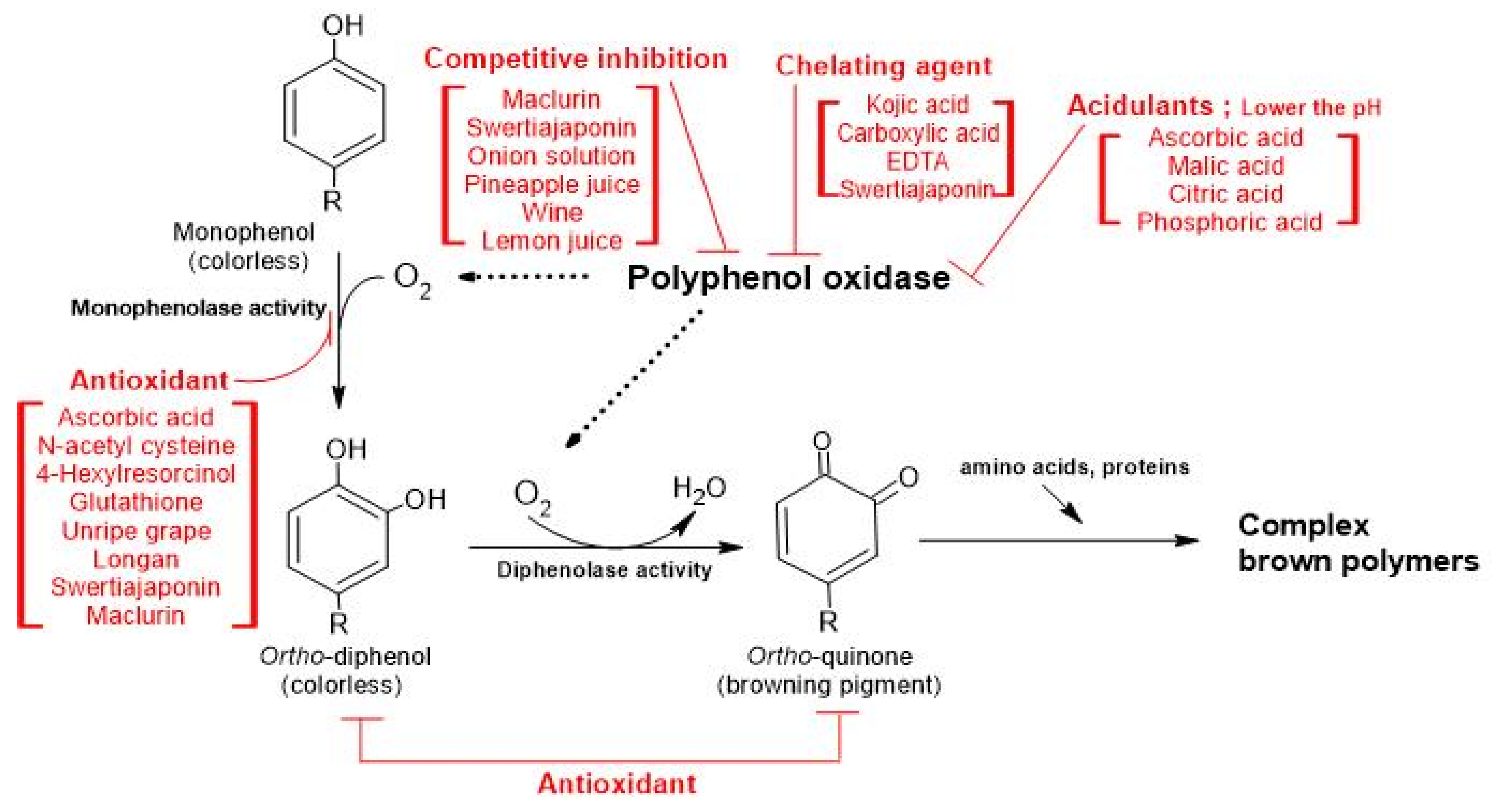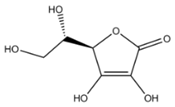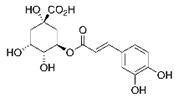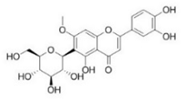Recent Trends in Controlling the Enzymatic Browning of Fruit and Vegetable Products
Abstract
1. Introduction
1.1. Enzymatic Browning
1.2. Polyphenol Oxidase Activity and Its Prevention
1.3. Current Trends in the Development of Anti-Browning Agents
2. Common Mechanisms Underlying the Anti-Browning Activity of Chemical PPO Inhibitors
2.1. Antioxidants/Reducing Agents
2.2. Chelating Agents
2.3. Acidulants
2.4. Mixed-Type Inhibitors
3. Natural Anti-Browning Agents
3.1. Onion
3.2. Pineapple
3.3. Lemon, Grape, and Wine
3.4. Dietary and Herbal Compounds
4. Food by-Products and Waste as Anti-Browning Agents
4.1. Unripe Grapes
4.2. Sapindaceae (Dimocarpus Longan and Nephelium Lappaceum) Seed and Peel By-Products
4.3. Microwaved Thinned Nectarine Extracts
4.4. Tomato Skin
5. Conclusions
Author Contributions
Funding
Conflicts of Interest
References
- Martinez, M.V.; Whitaker, J.R. The biochemistry and control of enzymatic browning. Trends Food Sci. Technol. 1995, 6, 195–200. [Google Scholar] [CrossRef]
- Marshall, M.R.; Kim, J.; Wei, C. Enzymatic Browning in Fruits, Vegetables and Seafoods; FAO: Rome, Italy, 2000; p. 49. [Google Scholar]
- Whitaker, J.R.; Lee, C.Y. Recent advances in chemistry of enzymatic browning: An overview. In Enzymatic Browning and Its Prevention; ACS Publications: American Chemical Society: Washington, DC, USA, 1995; pp. 2–7. [Google Scholar]
- Maillard, L. Action of amino acids on sugars. Formation of melanoidins in a methodical way. C. R. Acad. Sci. 1912, 154, 66–68. [Google Scholar]
- Queiroz, C.; Mendes Lopes, M.L.; Fialho, E.; Valente-Mesquita, V.L. Polyphenol oxidase: Characteristics and mechanisms of browning control. Food Rev. Int. 2008, 24, 361–375. [Google Scholar] [CrossRef]
- Mayer, A.M.; Harel, E. Polyphenol oxidases in plants. Phytochemistry 1979, 18, 193–215. [Google Scholar] [CrossRef]
- Devece, C.; Rodríguez-López, J.N.; Fenoll, L.G.; Tudela, J.; Catalá, J.M.; de los Reyes, E.; García-Cánovas, F. Enzyme inactivation analysis for industrial blanching applications: Comparison of microwave, conventional, and combination heat treatments on mushroom polyphenoloxidase activity. J. Agric. Food Chem. 1999, 47, 4506–4511. [Google Scholar] [CrossRef] [PubMed]
- Lee, C.; Smith, N. Blanching effect on polyphenol oxidase activity in table beets. J. Food Sci. 1979, 44, 82–83. [Google Scholar] [CrossRef]
- Macheix, J.J.; Sapis, J.C.; Fleuriet, A.; Lee, C. Phenolic compounds and polyphenoloxidase in relation to browning in grapes and wines. Crit. Rev. Food Sci. Nutr. 1991, 30, 441–486. [Google Scholar] [CrossRef]
- Rocha, A.; Morais, A.M. Influence of controlled atmosphere storage on polyphenoloxidase activity in relation to colour changes of minimally processed ‘Jonagored’apple. Int. J. Food Sci. Technol. 2001, 36, 425–432. [Google Scholar] [CrossRef]
- Murr, D.P.; Morris, L.L. Influence of O2 and CO2 on o-diphenol oxidase activity in mushrooms. J. Am. Soc. Hortic. Sci. 1974, 99, 155–158. [Google Scholar]
- Nicoli, M.; Anese, M.; Severini, C. Combined effects in preventing enzymatic browning reactions in minimally processed fruit. J. Food Qual. 1994, 17, 221–229. [Google Scholar] [CrossRef]
- Yousuf, B.; Qadri, O.S.; Srivastava, A.K. Recent developments in shelf-life extension of fresh-cut fruits and vegetables by application of different edible coatings: A review. LWT Food Sci. Technol. 2018, 89, 198–209. [Google Scholar] [CrossRef]
- Luna-Guzmán, I.; Cantwell, M.; Barrett, D.M. Fresh-cut cantaloupe: Effects of CaCl2 dips and heat treatments on firmness and metabolic activity. Postharvest Biol. Technol. 1999, 17, 201–213. [Google Scholar] [CrossRef]
- Chaves, A.; Zaritzky, N. Cooling and freezing of fruits and fruit products. In Fruit Preservation; Springer: Berlin/Heidelberg, Germany, 2018; pp. 127–180. [Google Scholar]
- Banerjee, A.; Suprasanna, P.; Variyar, P.S.; Sharma, A. Gamma irradiation inhibits wound induced browning in shredded cabbage. Food Chem. 2015, 173, 38–44. [Google Scholar] [CrossRef] [PubMed]
- Zemel, G.; Sims, C.; Marshall, M.; Balaban, M. Low pH inactivation of polyphenoloxidase in apple juice. J. Food Sci. 1990, 55, 562–563. [Google Scholar] [CrossRef]
- Sayavedra-Soto, L.; Montgomery, M. Inhibition of polyphenoloxidase by sulfite. J. Food Sci. 1986, 51, 1531–1536. [Google Scholar] [CrossRef]
- Arias, E.; Gonzalez, J.; Peiró, J.; Oria, R.; Lopez-Buesa, P. Browning prevention by ascorbic acid and 4-hexylresorcinol: Different mechanisms of action on polyphenol oxidase in the presence and in the absence of substrates. J. Food Sci. 2007, 72, C464–C470. [Google Scholar] [CrossRef]
- de Aguiar Cipriano, P.; Ekici, L.; Barnes, R.C.; Gomes, C.; Talcott, S.T. Pre-heating and polyphenol oxidase inhibition impact on extraction of purple sweet potato anthocyanins. Food Chem. 2015, 180, 227–234. [Google Scholar] [CrossRef]
- Brütsch, L.; Rugiero, S.; Serrano, S.; Städeli, C.; Windhab, E.; Fischer, P.; Kuster, S. Targeted inhibition of enzymatic browning in wheat pastry dough. J. Agric. Food Chem. 2018, 66, 12353–12360. [Google Scholar] [CrossRef]
- Kunal, A.; Amit, R. Processed Fruits and Vegetables Market Size by Type (Fruits, Vegetables), by Product (Fresh, Fresh-cut, Canned, Frozen, Drying & Dehydration), by Processing Equipment (Pre-processing, Processing, Washing, Filling, Seasoning, Packaging), Industry Analysis Report, Regional Outlook, Growth Potential, Price Trends, Competitive Market Share & Forecast, 2019–2025; Global Market Insights, Inc.: Selbyville, DE, USA, 2019; pp. 1–320. [Google Scholar]
- Taylor, S.L.; Higley, N.A.; Bush, R.K. Sulfites in foods: Uses, analytical methods, residues, fate, exposure assessment, metabolism, toxicity, and hypersensitivity. In Advances in Food Research; Elsevier: Amsterdam, The Netherlands, 1986; Volume 30, pp. 1–76. [Google Scholar]
- Macheix, J.J.; Fleuriet, A.; Billot, J. Fruit Phenolics; CRC Press: Boca Raton, FL, USA, 1990. [Google Scholar]
- Reisch, L.; Eberle, U.; Lorek, S. Sustainable food consumption: An overview of contemporary issues and policies. Sustain. Sci. Pract. Policy 2013, 9, 7–25. [Google Scholar] [CrossRef]
- Kowalska, H.; Czajkowska, K.; Cichowska, J.; Lenart, A. What’s new in biopotential of fruit and vegetable by-products applied in the food processing industry. Trends Food Sci. Technol. 2017, 67, 150–159. [Google Scholar] [CrossRef]
- Castro-Muñoz, R.; Yáñez-Fernández, J.; Fíla, V. Phenolic compounds recovered from agro-food by-products using membrane technologies: An overview. Food Chem. 2016, 213, 753–762. [Google Scholar] [CrossRef] [PubMed]
- Tinello, F.; Lante, A. Recent advances in controlling polyphenol oxidase activity of fruit and vegetable products. Innov. Food Sci. Emerg. Technol. 2018, 50, 73–83. [Google Scholar] [CrossRef]
- Lindley, M.G. The impact of food processing on antioxidants in vegetable oils, fruits and vegetables. Trends Food Sci. Technol. 1998, 9, 336–340. [Google Scholar] [CrossRef]
- Ioannou, I.; Ghoul, M. Prevention of enzymatic browning in fruit and vegetables. EJLST 2013, 9, 310–341. [Google Scholar]
- Singh, B.; Suri, K.; Shevkani, K.; Kaur, A.; Kaur, A.; Singh, N. Enzymatic browning of fruit and vegetables: A review. In Enzymes in Food Technology; Springer: Gateway East, Singapore, 2018; pp. 63–78. [Google Scholar]
- Oms-Oliu, G.; Aguiló-Aguayo, I.; Martín-Belloso, O. Inhibition of browning on fresh-cut pear wedges by natural compounds. J. Food Sci. 2006, 71, S216–S224. [Google Scholar] [CrossRef]
- Arias, E.; González-Buesa, J.; Oria, R.; López Buesa, P. Ascorbic acid and 4-hexylresorcinol effects on pear PPO and PPO catalyzed browning reaction. J. Food Sci. 2007, 72, C422–C429. [Google Scholar] [CrossRef] [PubMed]
- McEvily, A.J.; Iyengar, R.; Otwell, W.S. Inhibition of enzymatic browning in foods and beverages. Crit. Rev. Food Sci. Nutr. 1992, 32, 253–273. [Google Scholar] [CrossRef]
- Walker, J.R.L. Enzymatic browning in foods, its chemistry and control. Food Technol. 1977, 12, 19–25. [Google Scholar]
- Lee, B.; Moon, K.M.; Lee, B.S.; Yang, J.H.; Park, K.I.; Cho, W.K.; Ma, J.Y. Swertiajaponin inhibits skin pigmentation by dual mechanisms to suppress tyrosinase. Oncotarget 2017, 8, 95530–95541. [Google Scholar] [CrossRef]
- Jiang, Y.; Fu, J. Inhibition of polyphenol oxidase and the browning control of litchi fruit by glutathione and citric acid. Food Chem. 1998, 62, 49–52. [Google Scholar] [CrossRef]
- Altunkaya, A.; Gökmen, V. Effect of various anti-browning agents on phenolic compounds profile of fresh lettuce (L. sativa). Food Chem. 2009, 117, 122–126. [Google Scholar] [CrossRef]
- Gautam, S.; Sharma, A. Purification and characterization of polyphenol oxidase (PPO) from eggplant (Solanum melongena). Food Chem. 2012, 134, 1855–1861. [Google Scholar]
- Rojas-Graü, M.A.; Sobrino-López, A.; Soledad Tapia, M.; Martín-Belloso, O. Browning inhibition in fresh-cut ‘Fuji’ apple slices by natural antibrowning agents. J. Food Sci. 2006, 71, S59–S65. [Google Scholar] [CrossRef]
- Nicolas, J.; Richard-Forget, F.; Goupy, P.; Amiot, M.J.; Aubert, S. Enzymatic browning reactions in apple and apple products. Crit. Rev. Food Sci. Nutr. 1994, 34, 109–157. [Google Scholar] [CrossRef]
- Chen, Y.-H.; Lu, P.-J.; Hulme, C.; Shaw, A.Y. Synthesis of kojic acid-derived copper-chelating apoptosis inducing agents. Med. Chem. Res. 2013, 22, 995–1003. [Google Scholar] [CrossRef]
- Son, S.M.; Moon, K.D.; Lee, C.Y. Inhibitory effects of various antibrowning agents on apple slices. Food Chem. 2001, 73, 23–30. [Google Scholar] [CrossRef]
- De la Rosa, L.; Alvarez-Parrilla, E.; Moyers, E.; Villegas, M.; Ayala-Zavala, J.F.; Hernández, J.; Ruiz-Cruz, S.; Aguilar, G. Mechanism for the inhibition of apple juice enzymatic browning by Palo Fierro (desert ironweed) honey extract and other natural compounds. LWT Food Sci. Technol. 2011, 44, 269–276. [Google Scholar] [CrossRef]
- Tinello, F.; Lante, A. Evaluation of antibrowning and antioxidant activities in unripe grapes recovered during bunch thinning. Aust. J. Grape Wine Res. 2017, 23, 33–41. [Google Scholar] [CrossRef]
- Ding, C.-K.; Chachin, K.; Ueda, Y.; Wang, C.Y. Inhibition of loquat enzymatic browning by sulfhydryl compounds. Food Chem. 2002, 76, 213–218. [Google Scholar] [CrossRef]
- Sukhonthara, S.; Kaewka, K.; Theerakulkait, C. Inhibitory effect of rice bran extracts and its phenolic compounds on polyphenol oxidase activity and browning in potato and apple puree. Food Chem. 2016, 190, 922–927. [Google Scholar] [CrossRef] [PubMed]
- Huang, S.-J.; Lin, S.-Y.; Wang, T.-T.; Hsu, F.-C. Combining acetic acid and ethanol as an anti-browning treatment for lettuce butt discoloration through repression of the activity and expression of phenylalanine ammonia lyase. Postharvest Biol. Technol. 2020, 164, 111151. [Google Scholar] [CrossRef]
- Ibrahim, R.; Osman, A.; Saari, N.; Abdul Rahman, R. Effects of anti-browning treatments on the storage quality of minimally processed shredded cabbage. J. Food Agric. Environ. 2004, 2, 54–58. [Google Scholar]
- Bala, T.; Prasad BL, V.; Sastry, M.; Kahaly, M.U.; Waghmare, U.V. Interaction of different metal ions with carboxylic acid group: A quantitative study. J. Phys. Chem. A 2007, 111, 6183–6190. [Google Scholar] [CrossRef]
- Pizzocaro, F.; Torreggiani, D.; Gilardi, G. Inhibition of apple polyphenoloxidase (PPO) by ascorbic acid, citric acid, and sodium chloride. J. Food Process. Preserv. 1993, 17, 21–30. [Google Scholar] [CrossRef]
- Soccol, C.; Vandenberghe, L.; Rodrigues, C.; Pandey, A. New perspectives for ctric acid production and application. Food Technol. Biotechnol. 2006, 44, 141–149. [Google Scholar]
- Hodgkinson, A. Oxalate Content of Foods and Nutrition in Oxalic Acid in Biology and Medicine; Academic Press: London, UK, 1977; pp. 196–197. [Google Scholar]
- Hithamani, G.; Medappa, H.; Arugakeerthy, C.; Ramalakshmi, K.; Raghavarao, K. Effect of adsorbent and acidulants on enzymatic browning of sugarcane juice. J. Food Sci. Technol. 2018, 55, 4356–4362. [Google Scholar] [CrossRef]
- Mi Moon, K.; Young Kim, C.; Yeul Ma, J.; Lee, B. Xanthone-related compounds as an anti-browning and antioxidant food additive. Food Chem. 2019, 274, 345–350. [Google Scholar] [CrossRef]
- Moon, K.M.; Lee, B.; Cho, W.K.; Lee, B.S.; Kim, C.Y.; Ma, J.Y. Swertiajaponin as an anti-browning and antioxidant flavonoid. Food Chem. 2018, 252, 207–214. [Google Scholar] [CrossRef]
- Lee, B.; Moon, K.M.; Lim, J.S.; Park, Y.; Kim, D.H.; Son, S.; Jeong, H.O.; Kim, D.H.; Lee, E.K.; Chung, K.W.; et al. 2-(3, 4-dihydroxybenzylidene)malononitrile as a novel anti-melanogenic compound. Oncotarget 2017, 8, 91481–91493. [Google Scholar] [CrossRef]
- Griffiths, G.; Trueman, L.; Crowther, T.; Thomas, B.; Smith, B. Onions—A global benefit to health. Phytother. Res. 2002, 16, 603–615. [Google Scholar] [CrossRef]
- Lee, M.K.; Kim, Y.M.; Kim, N.Y.; Kim, G.N.; Kim, S.H.; Bang, K.S.; Park, I. Prevention of browning in potato with a heat-treated onion extract. Biosci. Biotechnol. Biochem. 2002, 66, 856–858. [Google Scholar] [CrossRef] [PubMed]
- Kim, M.J.; Kim, C.Y.; Park, I. Prevention of enzymatic browning of pear by onion extract. Food Chem. 2005, 89, 181–184. [Google Scholar] [CrossRef]
- Lee, B.; Seo, J.D.; Rhee, J.K.; Kim, C.Y. Heated apple juice supplemented with onion has greatly improved nutritional quality and browning index. Food Chem. 2016, 201, 315–319. [Google Scholar] [CrossRef] [PubMed]
- Chaisakdanugull, C.; Theerakulkait, C.; Wrolstad, R.E. Pineapple juice and its fractions in enzymatic browning inhibition of banana [Musa (AAA Group) Gros Michel]. J. Agric. Food Chem. 2007, 55, 4252–4257. [Google Scholar] [CrossRef] [PubMed]
- Lozano-de-Gonzalez, P.G.; Barrett, D.M.; Wrolstad, R.E.; Durst, R.W. Enzymatic browning inhibited in fresh and dried apple rings by pineapple juice. J. Food Sci. 1993, 58, 399–404. [Google Scholar] [CrossRef]
- Woo, K.S.; Hwang, I.G.; Kim, T.M.; Kim, D.J.; Hong, J.T.; Jeong, H.S. Changes in the antioxidant activity of onion (Allium cepa) extracts with heat treatment. Food Sci. Biotechnol. 2007, 16, 828–831. [Google Scholar]
- Burlando, B.; Clericuzio, M.; Cornara, L. Moraceae plants with tyrosinase inhibitory activity: A review. Mini Rev. Med. Chem. 2017, 17, 108–121. [Google Scholar] [CrossRef]
- Adhikari, A.; Devkota, H.P.; Takano, A.; Masuda, K.; Nakane, T.; Basnet, P.; Skalko-Basnet, N. Screening of Nepalese crude drugs traditionally used to treat hyperpigmentation: In vitro tyrosinase inhibition. Int. J. Cosmet. Sci. 2008, 30, 353–360. [Google Scholar] [CrossRef]
- Paudel, P.; Seong, S.H.; Wagle, A.; Min, B.S.; Jung, H.A.; Choi, J.S. Antioxidant and anti-browning property of 2-arylbenzofuran derivatives from Morus alba Linn root bark. Food Chem. 2020, 309, 125739. [Google Scholar] [CrossRef]
- Szente, L.; Szejtli, J. Cyclodextrins as food ingredients. Trends Food Sci. Technol. 2004, 15, 137–142. [Google Scholar] [CrossRef]
- López-Nicolás, J.M.; Rodríguez-Bonilla, P.; García-Carmona, F. Cyclodextrins and antioxidants. Crit. Rev. Food Sci. Nutr. 2014, 54, 251–276. [Google Scholar] [CrossRef] [PubMed]
- López-Nicolás, J.M.; García-Carmona, F. Use of cyclodextrins as secondary antioxidants to improve the color of fresh pear juice. J. Agric. Food Chem. 2007, 55, 6330–6338. [Google Scholar] [CrossRef] [PubMed]
- López-Nicolás, J.M.; Núñez-Delicado, E.; Sánchez-Ferrer, Á.; García-Carmona, F. Kinetic model of apple juice enzymatic browning in the presence of cyclodextrins: The use of maltosyl-β-cyclodextrin as secondary antioxidant. Food Chem. 2007, 101, 1164–1171. [Google Scholar] [CrossRef]
- López-Nicolás, J.M.; Pérez-López, A.J.; Carbonell-Barrachina, Á.; García-Carmona, F. Use of natural and modified cyclodextrins as inhibiting agents of peach juice enzymatic browning. J. Agric. Food Chem. 2007, 55, 5312–5319. [Google Scholar] [CrossRef] [PubMed]
- Núñez-Delicado, E.; Serrano-Megías, M.; Pérez-López, A.J.; López-Nicolás, J.M. Polyphenol oxidase from dominga table grape. J. Agric. Food Chem. 2005, 53, 6087–6093. [Google Scholar] [CrossRef]
- Honisch, C.; Osto, A.; Dupas de Matos, A.; Vincenzi, S.; Ruzza, P. Isolation of a tyrosinase inhibitor from unripe grapes juice: A spectrophotometric study. Food Chem. 2020, 305, 125506. [Google Scholar] [CrossRef] [PubMed]
- Rangkadilok, N.; Sitthimonchai, S.; Worasuttayangkurn, L.; Mahidol, C.; Ruchirawat, M.; Satayavivad, J. Evaluation of free radical scavenging and antityrosinase activities of standardized longan fruit extract. Food Chem. Toxicol. 2007, 45, 328–336. [Google Scholar] [CrossRef]
- Prasad, K.N.; Yang, B.; Shi, J.; Yu, C.; Zhao, M.; Xue, S.; Jiang, Y. Enhanced antioxidant and antityrosinase activities of longan fruit pericarp by ultra-high-pressure-assisted extraction. J. Pharm. Biomed. Anal. 2010, 51, 471–477. [Google Scholar] [CrossRef]
- Redondo, D.; Venturini, M.E.; Oria, R.; Arias, E. Inhibitory effect of microwaved thinned nectarine extracts on polyphenol oxidase activity. Food Chem. 2016, 197, 603–610. [Google Scholar] [CrossRef]
- Martínez-Hernández, G.B.; Castillejo, N.; Artés-Hernández, F. Effect of fresh–cut apples fortification with lycopene microspheres, revalorized from tomato by-products, during shelf life. Postharvest Biol. Technol. 2019, 156, 110925. [Google Scholar] [CrossRef]
- Rakariyatham, K.; Zhou, D.; Rakariyatham, N.; Shahidi, F. Sapindaceae (Dimocarpus longan and Nephelium lappaceum) seed and peel by-products: Potential sources for phenolic compounds and use as functional ingredients in food and health applications. J. Funct. Foods 2020, 67, 103846. [Google Scholar] [CrossRef]
- Martín, B.; Torregrosa, A.; Garcia Brunton, J. Post-bloom thinning of peaches for canning with hand-held mechanical devices. Sci. Hortic. 2010, 125, 658–665. [Google Scholar] [CrossRef]
- Zheng, H.-Z.; Kim, Y.-I.; Chung, S.-K. A profile of physicochemical and antioxidant changes during fruit growth for the utilisation of unripe apples. Food Chem. 2012, 131, 106–110. [Google Scholar] [CrossRef]
- Moco, S.; Capanoglu, E.; Tikunov, Y.; Bino, R.J.; Boyacioglu, D.; Hall, R.D.; Vervoort, J.; De Vos, R.C.H. Tissue specialization at the metabolite level is perceived during the development of tomato fruit. J. Exp. Bot. 2007, 58, 4131–4146. [Google Scholar] [CrossRef] [PubMed]

| Compound | Structure | Conc.1 | Product | Effect | Ref. |
|---|---|---|---|---|---|
| Ascorbic acid |  | 5 mM 0.3 mM | Apple juice | Reducing oxidant substrates Reduction of o-quinones to their precursor diphenols | [34,35] |
| N-acetyl cysteine |  | 1.7 mM 25 mM | Potato Apple | Competitive inhibition of PPO 2 Reactive oxygen species scavenger | [33] |
| 4-Hexylresorcinol |  | 1.8 μM | Peer Apple | PPO inactivation Synergistic inhibition with ascorbic acid and N-acetyl cysteine | [32,33] |
| Glutathione |  | 0.08% | Peer Apple juice | Inhibited PPO activity | [36,37] |
| Cysteine hydrochloride |  | 1.8 μM 1% | Fruit salad | Inhibited PPO activity | [38,39] |
| Erythorbic acid |  | 19.6 μM | Fruit salad | Inhibited PPO activity Oxygen scavenger | [38,39] |
| Compound | Structure | Conc. 1 | Product | Effect | Ref. |
|---|---|---|---|---|---|
| Citric acid |  | 2.7 mM | Lettuce-head | PPO 2 noncompetitive inhibitor | [38] |
| Kojic acid |  | 25 μM | Apple Potato | Strong chelator such as Fe(III) and Cu(II) Inactivated PPO enzyme (bind to Cu in PPO) | [42,43] |
| Oxalic acid |  | 2.0 mM 10 μM | Apple Lettuce | Chelating copper from the active site of PPO PPO noncompetitive inhibitor | [38] |
| Caffeic acid |  | 955.7 μM | Apple juice Unripe grapes juice | Low inhibitory activity on enzymatic browning | [44,45] |
| Chlorogenic acid |  | 1 mM | Loquat juice | Prevention of enzymatic browning through inactivating PPO | [46] |
| Coumaric acid |  | 50 μg/mL | Potato Apple puree | Inhibited PPO activity | [47] |
| Gallic acid |  | 59.2 μM | Unripe grapes juice | Low inhibitory activity on enzymatic browning | [45] |
| Carboxylic acid |  | 1% | Apple | Inhibitory effects on enzymatic browning due to metal-chelating activities or lowering pH | [43] |
| Oxaloacetic acid |  | 1% | Apple | Inhibitory effects on enzymatic browning due to metal-chelating characteristics or lowering pH | [43] |
| Lactic acid |  | 1% | Apple | Inhibitory effects on enzymatic browning because of their metal- chelating characteristics or lowering pH | [43] |
| Malic acid |  | 163.8 mM | Unripe grapes juice | Inhibitory effects on enzymatic browning because of their metal-chelating characteristics or lowering pH | [43] |
| Pyruvic acid |  | 1% | Apple | Inhibitory effects on enzymatic browning due to metal-chelating characteristics or lowering pH | [43] |
| Acetic acid |  | 0.1% | Lettuce-head Cabbage | No apparent effect on PPO activity | [48,49] |
| Succinic acid |  | 536.7 mM | Unripe grapes juice | Less effective in controlling enzyme browning | [45] |
| Formic acid |  | 1% | Apple | Less effective in controlling enzymatic browning Inhibitory effects on enzymatic browning because of their metal-chelating characteristics or lowering pH | [43,45] |
| Compound | Structure | Conc. 1 | Product | Effect | Ref. |
|---|---|---|---|---|---|
| Maclurin |  | 1 and 10 μM | Potato | ROS 2 and peroynitrite 3 scavenger Tyrosinase binding and inactivation | [57] |
| Swertiajaponin |  | 5–500 μM | Potato | Suppressed ROS generation Tyrosinase binding and inactivation | [36,56] |
| Source | Extraction Condition | Product | Conc. 1 | Result | Ref |
|---|---|---|---|---|---|
| Onion | Heat (96 °C/1 h) | Apple juice | 2.5% | Reduced browning by inhibition of PPO 2 (53.87%) | [61] |
| Heat (100 °C/10 min) | Potato extract/slice | 3.1 mg/mL | Decreased browning by non-competitive inhibition of PPO | [59] | |
| Heat (100 °C/10 min) | Pear juice | 60 mg/mL | Prevention of enzymatic browning by PPO inhibition (45.9%) | [60] | |
| Pine-apple | Crush and freeze dry | Banana slice | Dipping in 12 °Brix | Effective enzymatic browning inhibition in banana slices stored at 15 °C for 3 days (PPO inhibition 52.3%) | [62] |
| Concentrated pineapple juices | Apple rings | Dipping in 13.0 °Brix | Inhibition of PPO at least 25% | [63] | |
| Wine | Commercial product | Pastry dough 10 gdm | Prevention of enzymatic browning and mold formation | [21] | |
| Lemon | Freshly squeezed | ||||
| Source | Extraction Condition | Product | Result | Ref |
|---|---|---|---|---|
| Unripe grape | Crushing and vacuum filtration components (Separated by HPLC) | Caftaric acid | Inhibition of tyrosinase competitively (Tyr IC50 1: 30 µM caftaric acid, 42 µM caffeic acid and 65 µM chlorogenic acid) | [74] |
| Chlorogenic acid | ||||
| Caffeic acid | ||||
| Centrifuged and filtration | Merlot and Barbera in the 2013 and 2014 seasons | Antioxidant and whitening activities (Tyr IC50: 14.7 mmol/L M1, 16.8 mmol/L M2, 2.5 mmol/L B1, and 3.2 mmol/L B2) 2013: M1, B1 and 2014: M2, B2) | [45] | |
| Longan | Dry and ultra-high-pressure-assisted extraction (UHPE) | 100 g/mL UHPE (pressures of 500 MPa) | High phenolic contents, high antioxidant and anti-tyrosinase activities (anti-tyrosinase activity: 23.6 ± 1.2) | [75] |
| Extracted and lyophilized | Dried seed extracts | High antioxidant activity and tyrosinase inactivation (Tyr IC50 values: 2.9 and 3.2 mg/mL) | [76] | |
| Thinned nectarine extracts | After dried nectarines were mixed with distilled water, microwaved | Microwave (1500 W power)-treated thinned nectarine extracts | 1500 W MRP inhibited the enzymatic browning in minimally processed peaches for 8 days of storage | [77] |
| Tomato skin | High lycopene extraction from tomato skin | Dipping solution containing 2 g of lycopene microspheres per L. (in fresh-cut processing of apples) | Reduced browning and some bioactive compounds even enhanced for 9 days Browning index (BI = 43.8) | [78] |
© 2020 by the authors. Licensee MDPI, Basel, Switzerland. This article is an open access article distributed under the terms and conditions of the Creative Commons Attribution (CC BY) license (http://creativecommons.org/licenses/by/4.0/).
Share and Cite
Moon, K.M.; Kwon, E.-B.; Lee, B.; Kim, C.Y. Recent Trends in Controlling the Enzymatic Browning of Fruit and Vegetable Products. Molecules 2020, 25, 2754. https://doi.org/10.3390/molecules25122754
Moon KM, Kwon E-B, Lee B, Kim CY. Recent Trends in Controlling the Enzymatic Browning of Fruit and Vegetable Products. Molecules. 2020; 25(12):2754. https://doi.org/10.3390/molecules25122754
Chicago/Turabian StyleMoon, Kyoung Mi, Eun-Bin Kwon, Bonggi Lee, and Choon Young Kim. 2020. "Recent Trends in Controlling the Enzymatic Browning of Fruit and Vegetable Products" Molecules 25, no. 12: 2754. https://doi.org/10.3390/molecules25122754
APA StyleMoon, K. M., Kwon, E.-B., Lee, B., & Kim, C. Y. (2020). Recent Trends in Controlling the Enzymatic Browning of Fruit and Vegetable Products. Molecules, 25(12), 2754. https://doi.org/10.3390/molecules25122754







